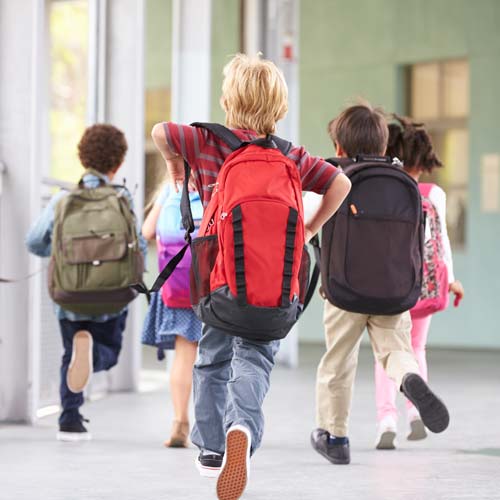Backpack Safety

September is quickly approaching and as we get closer to Labor Day, we get closer to back to school. Back to school commercials are everywhere and all the stores have their shelves lined with back to school supplies like notebooks, pencils, tablets and backpacks. While the thought of back to school shopping may be exciting for some, others find it stressful.
This is due to many different factors; however one of the most stressful factors, especially for one’s spine, is the return of backpack use. It is inevitable that students have to use backpacks so it is important to wear them properly and safely.
If you’ve ever lifted up your child’s backpack you have realized that they are carrying more weight than you thought. Students should carry no more than 10% – 20% of their body weight and most students unfortunately carry more. Wearing backpacks that weigh more than 10%-20% of your body weight can lead to multiple different back and spine issues.
In this week’s blog we are going to discuss what those issues are, how to avoid them, what to look for in a good backpack, and how to properly wear one.
How do you properly wear a backpack?
Students should be wearing a backpack with both of the straps snugly fit on their shoulders, not just hanging off on one. You don’t want the backpack to fall below the waist. Students should also be sure that the heavier items are placed closer to the bottom of the backpack rather than on top.It is also important to have your backpacks straps fastened at hip level. This can help prevent the backpack from moving along with the student and helps to decrease the risk of injury.
What issues can come from using backpacks improperly?
Using a backpack improperly may lead to many different spinal issues. Some of these issues include: neck pain, upper back pain, headaches, rounded shoulders, numbness and tingling in the arms, and abnormal posture. Children have spines that are more impressionable than adults. Their spines can not handle as much force as an adults. That’s why it important to know how much their backpack weighs and adjust them accordingly.
What to look for in a backpack?
There are three main areas when it comes to choosing the right backpack for your child. They are: backpack capacity, backpack features, and backpack fit. They all are equally important. Capacity is related to how much weight it will hold, features will vary depending on the needs of the student, and the fit is determined by torso length, not height. As the student grows, the backpack size will as well.
What can students do?
Students can do multiple things to help reduce the risk of hurting their spines due to their backpack. One of these ways is to wear their backpack properly. This is one of the easiest ways to reduce the risk of backpack wearing injuries. Another way is to limit the things that they carrying in their backpack. This does not just include textbooks, but also personal items as well. Sometimes children want to bring toys, crayons, and other things in their backpack. Limiting these things can help not only prevent injury, but also limit possible school distractions.
What can parents do?
One of the most important things a parent can do is teach their child to maintain good posture with and without the backpack. Teach them about “tech neck” and how to take breaks on their phones and tablets, especially when their backpacks are on. Looking down on a phone with a heavy backpack on creates abnormal tension on the spine and increases the risk of spinal and postural injuries. Starting children young with good posture habits can help reduce their chances of developing these preventable issues later on in life.
We can also help to educate the children on ways to advocate for themselves during school hours. This includes talking to their teachers on ways to reduce their backpack weight. Encourage your children to take books out of their backpack and carry them instead to help lighten the load on their spines. Check and weigh the backpack throughout the school year and not just in the beginning of the school year.
What can the schools do?
Schools and teachers are in a tough spot because most children have to carry their textbooks and supplies home at the end of the day. As technology advances, we are seeing more online textbooks become available. This helps prevent children from carrying their books and lowers the risk of hurting their spines.
With all of this information in mind, you can feel confident that your child is going back to school this year properly wearing his or her backpack and not injuring their spine because of it.
